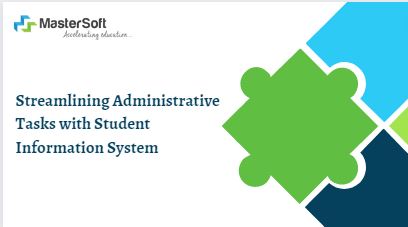In the rapidly evolving landscape of education, the demand for efficient administrative processes has never been higher. Educational institutions, whether schools, colleges, or universities, are constantly seeking ways to streamline their administrative tasks to enhance productivity and provide better services. One transformative solution that has gained prominence in recent years is the implementation of a Student Information System (SIS). In this blog post, we will explore how a Student Information System can significantly contribute to streamlining administrative tasks in the educational sector.
Understanding the Student Information System (SIS):
A Student Information System is a comprehensive software application specifically designed to manage student data efficiently. It serves as a centralized platform that integrates various administrative processes, including student enrollment, registration, attendance tracking, grades management, and more. By automating these tasks, an Student Information System not only reduces the administrative burden on educational institutions but also improves data accuracy and accessibility.
Key Benefits of Implementing a Student Information System:
1. Efficient Enrollment and Registration:
- With an Student Information System, the traditional, paper-based enrollment and registration processes can be digitized. Students can submit applications online, and administrators can process them seamlessly. This not only saves time but also reduces the chances of errors.
2. Streamlined Attendance Tracking:
- Manual attendance tracking is a time-consuming process prone to errors. An Student Information System automates this task, allowing teachers to take attendance electronically. This ensures real-time data accuracy and enables quick identification of attendance trends.
3. Centralized Data Management:
- All student-related information, including personal details, academic records, and attendance data, is stored in a centralized database. This ensures that administrators have easy access to accurate and up-to-date information, eliminating the need to sift through multiple systems or paperwork.
4. Grades and Performance Management:
- The traditional grading process is often cumbersome. An School Management software simplifies the grading process by allowing educators to input grades electronically. This not only speeds up the grading process but also provides a transparent view of student performance for both educators and students.
5. Communication and Collaboration:
- An Student Information System facilitates effective communication between administrators, teachers, students, and parents. Important announcements, grades, and other relevant information can be easily communicated through the system, fostering a collaborative and transparent educational environment.
6. Data Security and Compliance:
- Student Information System platforms prioritize data security and compliance with privacy regulations. This ensures that sensitive student information is protect, and institutions remain in adherence to legal requirements.
What is Student Management System?
A Student Information System (SIS), also known as a Student Management System (SMS) or Student Record System (SRS), is a comprehensive software application design to manage various aspects of student-relate data within an educational institution. The primary purpose of an SIS is to streamline administrative tasks, enhance data accuracy, and improve overall efficiency in managing student information. Here are key components and features typically found in a Student Information System:
1. Student Enrollment and Registration:
- SIS systems facilitate the digital submission and processing of student enrollment and registration forms. This includes collecting and storing essential information such as personal details, contact information, and academic history.
2. Attendance Tracking:
- Automated attendance tracking is a core feature of an SIS. It allows educators to record and monitor student attendance electronically, providing real-time data on student presence and enabling timely intervention when needed.
3. Academic Records and Grades Management:
- SIS platforms centralize academic records, including grades, transcripts, and other performance-related data. This feature simplifies the grading process, allowing educators to input grades electronically and providing a transparent view of student progress over time.
4. Communication and Collaboration:
- SIS systems often include communication tools that facilitate effective interaction between administrators, teachers, students, and parents. Announcements, updates, and other important information can be share through the system, fostering collaboration and transparency.
5. Timetable and Course Scheduling:
- SIS helps in creating and managing class schedules, ensuring that students are assign to appropriate courses and have access to necessary resources. This feature aids in optimizing resource utilization and avoiding scheduling conflicts.
6. Financial Management:
- Some SIS platforms integrate financial management features, allowing educational institutions to handle tasks such as fee collection, invoicing, and financial reporting. This integration helps streamline the financial aspects of student management.
7. Data Security and Privacy Compliance:
- SIS platforms prioritize data security to safeguard sensitive student information. They often comply with privacy regulations and security standards to ensure that student data is protect and that the institution remains in adherence to legal requirements.
8. Reporting and Analytics:
- SIS systems provide tools for generating various reports and analytics related to student performance, attendance trends, and other relevant data. These insights support informed decision-making by educators and administrators
9. User Access and Roles:
- SIS platforms often have role-based access control, allowing different users (administrators, teachers, students, parents) to access specific information based on their roles within the educational institution.
Conclusion:
In conclusion, the implementation of a Student Information System represents a significant leap forward in the quest for efficient administrative processes in educational institutions. By automating tasks such as enrollment, attendance tracking, grades management, and communication, an SIS not only streamlines administrative workflows but also enhances overall productivity. Educational institutions that embrace this technology position themselves to provide a more seamless and effective learning experience for both students and staff, ultimately contributing to the advancement of the education sector as a whole.
